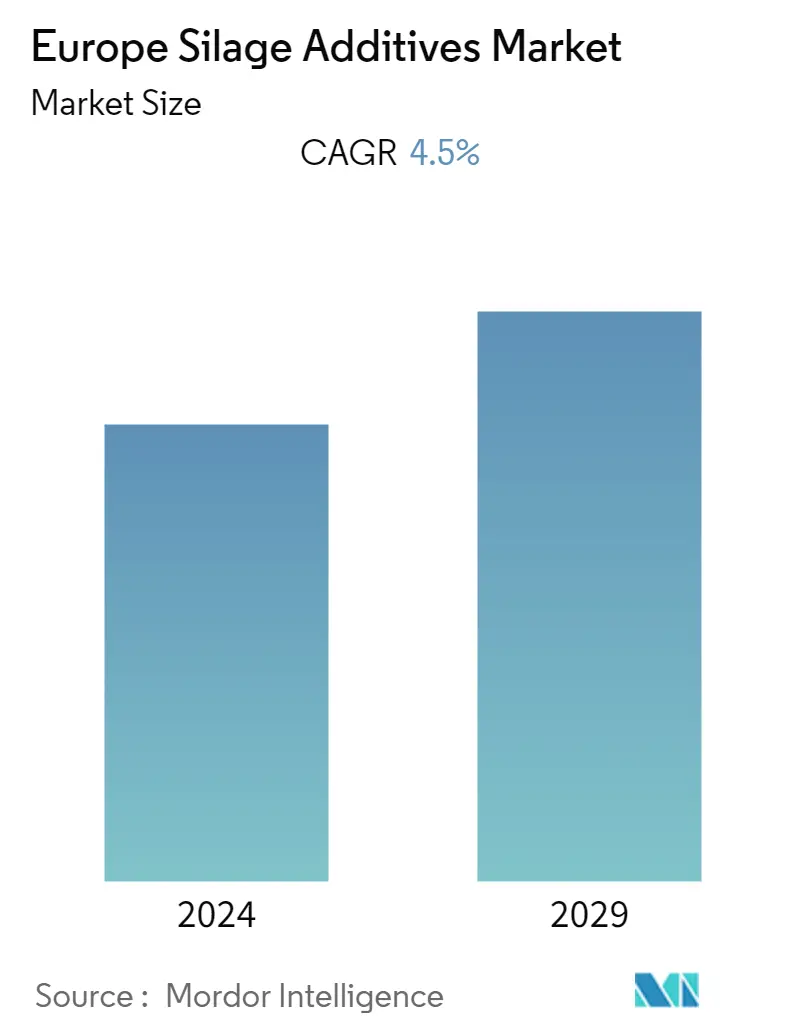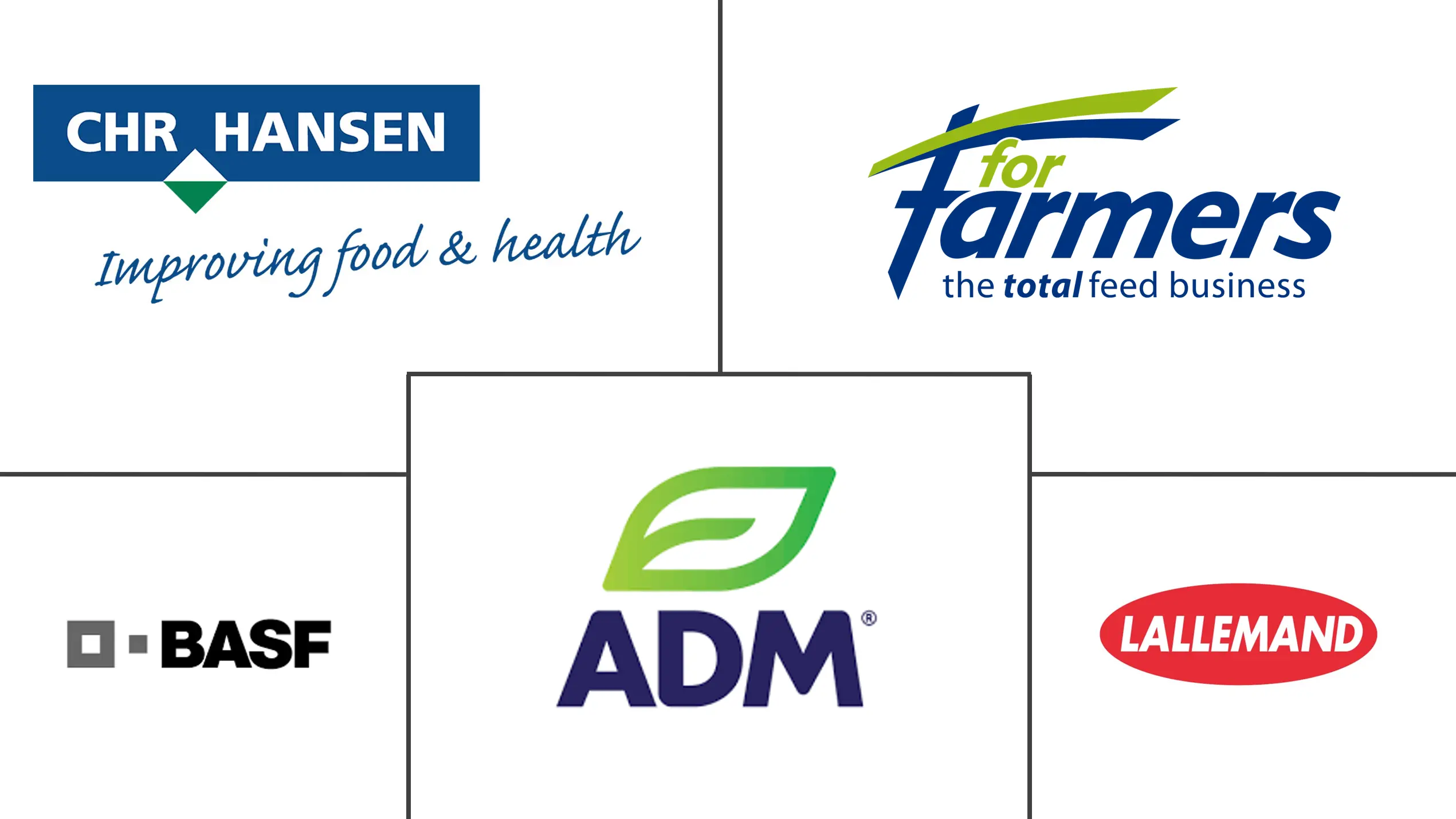Market Size of Europe Silage Additives Industry

| Study Period | 2019 - 2029 |
| Base Year For Estimation | 2023 |
| Forecast Data Period | 2024 - 2029 |
| Historical Data Period | 2019 - 2022 |
| CAGR | 4.50 % |
| Market Concentration | Medium |
Major Players
*Disclaimer: Major Players sorted in no particular order |
Europe Silage Additives Market Analysis
The Europe Silage Additives Market is projected to register a CAGR of 4.5% over the forecast period (2020-2025). Silage is an important means of preservation of fresh fodder for animals for the availability of roughage and nutrients during extreme weather conditions. The production of silage is a well-established practice in Europe. The development of innovative products and increased focus on R&D by companies is expected to be one of the key factors driving the adoption of silage additives. With an increase in awareness regarding the usability of silage as a substitute for fresh fodder or hay, the practice of production of silage, as a whole is expected to continue to increase. Increased industrialization of livestock production, driven by increased demand for animal protein by end consumers is driving farmers to adopt optimum nutrition for cattle, leading to an increased usage of silage additives.
Europe Silage Additives Industry Segmentation
The Europe Silage Additives Market is segmented by Type into Silage Inoculants, Organic Acids & Salts, Enzymes, Adsorbents, Preservatives, and Other Types, and by Silage Type into Cereals, Legumes, and Other Silage Types. The market is also segmented by geography to cover the key market trends across major countries such as Germany, United Kingdom, France, Spain, Russia, Italy and Rest of Europe.
| Type | |
| Inoculants | |
| Organic Acids & Salts | |
| Enzymes | |
| Adsorbents | |
| Preservatives | |
| Other Types |
| Silage Type | |
| Cereals | |
| Legumes | |
| Other Silage Types |
| Geography | |
| Germany | |
| United Kingdom | |
| France | |
| Spain | |
| Russia | |
| Italy | |
| Rest of Europe |
Europe Silage Additives Market Size Summary
The Europe Silage Additives Market is experiencing a steady growth trajectory, driven by the increasing need for effective preservation of animal fodder to ensure nutrient availability during adverse weather conditions. The practice of silage production is well-established in Europe, and the market is poised for expansion due to the development of innovative products and a heightened focus on research and development by key industry players. As awareness grows regarding the benefits of silage as a substitute for fresh fodder, and with the industrialization of livestock production on the rise, farmers are increasingly adopting silage additives to optimize cattle nutrition. This trend is further fueled by the growing demand for safe and high-value animal protein, which is closely linked to population growth, rising incomes, and urbanization in developing regions.
The use of silage additives is crucial for enhancing the fermentation process and preserving true protein while minimizing undesirable microbial activity. Inoculants, in particular, play a significant role in reducing dry matter losses and improving silage digestibility, especially when combined with effective silage management practices. The European meat market's sustained growth and high consumption of meat products are expected to bolster the silage additives market. The market is moderately consolidated, with major global players like BASF SE, Archer Daniels Midland Company, and ForFarmers NV leading the charge through substantial investments in R&D to enhance product performance. This competitive landscape is anticipated to drive further innovation and dynamism in the market over the forecast period.
Europe Silage Additives Market Size - Table of Contents
-
1. MARKET DYNAMICS
-
1.1 Market Overview
-
1.2 Market Drivers
-
1.3 Market Restraints
-
1.4 Porter's Five Force Analysis
-
1.4.1 Bargaining Power of Suppliers
-
1.4.2 Bargaining Power of Buyers
-
1.4.3 Threat of New Entrants
-
1.4.4 Threat of Substitute Products
-
1.4.5 Intensity of Competitive Rivalry
-
-
-
2. MARKET SEGMENTATION
-
2.1 Type
-
2.1.1 Inoculants
-
2.1.2 Organic Acids & Salts
-
2.1.3 Enzymes
-
2.1.4 Adsorbents
-
2.1.5 Preservatives
-
2.1.6 Other Types
-
-
2.2 Silage Type
-
2.2.1 Cereals
-
2.2.2 Legumes
-
2.2.3 Other Silage Types
-
-
2.3 Geography
-
2.3.1 Germany
-
2.3.2 United Kingdom
-
2.3.3 France
-
2.3.4 Spain
-
2.3.5 Russia
-
2.3.6 Italy
-
2.3.7 Rest of Europe
-
-
Europe Silage Additives Market Size FAQs
What is the current Europe Silage Additives Market size?
The Europe Silage Additives Market is projected to register a CAGR of 4.5% during the forecast period (2024-2029)
Who are the key players in Europe Silage Additives Market?
BASF SE, Archer Daniels Midland Company , ForFarmers NV, Chr. Hansen and Lallemand Animal Nutrition are the major companies operating in the Europe Silage Additives Market.

